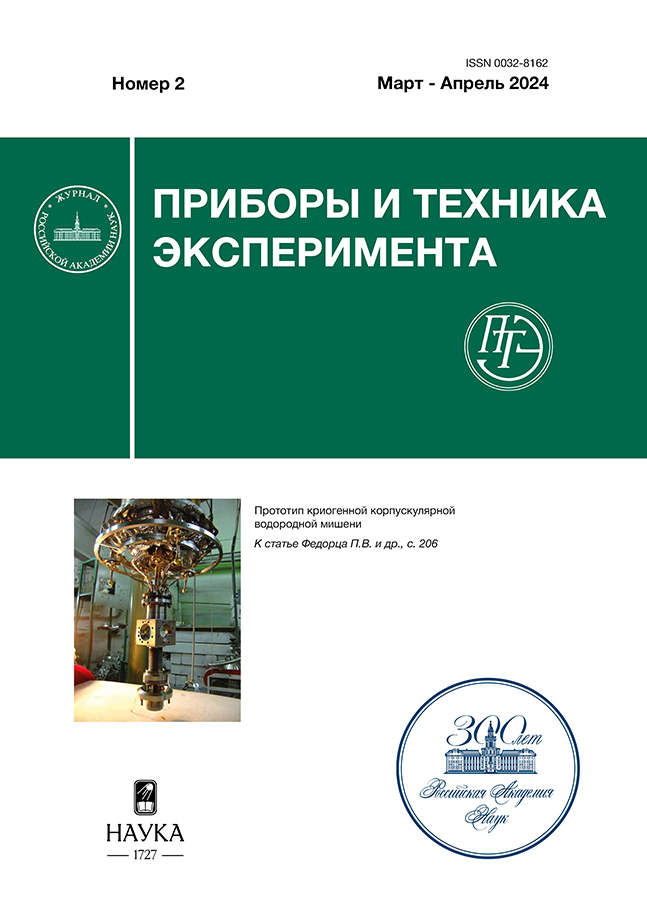Применение методов ядерной физики для диагностики плазмы на основе газодинамической ловушки
- 作者: Пинженин Е.И.1, Максимов B.B.1
-
隶属关系:
- Институт ядерной физики им. Г. И. Будкера Сибирского отделения Российской академии наук
- 期: 编号 2 (2024)
- 页面: 53–63
- 栏目: ТЕХНИКА ЯДЕРНОГО ЭКСПЕРИМЕНТА
- URL: https://rjraap.com/0032-8162/article/view/670197
- DOI: https://doi.org/10.31857/S0032816224020078
- EDN: https://elibrary.ru/QTDNBD
- ID: 670197
如何引用文章
详细
Описан диагностический комплекс, созданный на основе газодинамической ловушки (ГДЛ), для регистрации продуктов синтеза ядер дейтерия, а также рентгеновских и гамма-квантов, возникающих в результате взаимодействия перегретых электронов с элементами конструкции и в результате захвата нейтронов ядрами окружающих материалов. В его состав входят следующие три подсистемы. Первая подсистема создана для регистрации продольного профиля интенсивности dd-реакции. Она построена на основе диодов, которые чувствительны к протонам с энергией 3.02 МэВ, и предусилителей, способных работать с диодами большой площади, смонтированными в специально разработанные детекторные модули. Детекторы расположены внутри вакуумной камеры ГДЛ, они работают в режиме счета отдельных частиц, что позволяет вести абсолютные измерения потока продуктов реакции с временным разрешением около 100 мкс. Такие детекторы были разработаны с учетом опыта эксплуатации на ГДЛ детектора протонов с энергией 3.02 МэВ на основе экспериментального диода. Вторая подсистема – ранее разработанные детекторы на основе пластикового сцинтиллятора СПМ-5 и фотоэлектронного умножителя (ФЭУ). Они работают в токовом режиме и предназначены для измерения интенсивности генерации нейтронов с временным разрешением до 25 мкс. В экспериментах с дополнительным нагревом эти детекторы стали использоваться (совместно с протонными детекторами) для определения вклада гамма-квантов и жесткого рентгеновского излучения. Третья подсистема – недавно разработанный спектрометр нейтронов и гамма-квантов на основе стильбенового сцинтиллятора и ФЭУ, он впервые применен в эксперименте с дейтериевой плазмой на ГДЛ. Детектор позволяет разделять частицы различных сортов, в том числе в режимах работы установки, в которых происходит генерация перегретых электронов.
全文:
作者简介
Е. Пинженин
Институт ядерной физики им. Г. И. Будкера Сибирского отделения Российской академии наук
编辑信件的主要联系方式.
Email: e.i.pinzhenin@inp.nsk.su
俄罗斯联邦, 630090, Новосибирск, просп. Академика Лаврентьева, 11
B. Максимов
Институт ядерной физики им. Г. И. Будкера Сибирского отделения Российской академии наук
Email: v.v.maximov@inp.nsk.su
俄罗斯联邦, 630090, Новосибирск, просп. Академика Лаврентьева, 11
参考
- Иванов А.А., Приходько В.В. // Успехи физических наук. 2017. Т. 187. № 5. С. 547. https://doi.org/10.3367/UFNr.2016.09.037967
- Beklemishev A., Anikeev A., Astrelin V., Bagryansky P., Burdakov A., Davydenko V., Gavrilenko D., Ivanov A., Ivanov I., Ivantsivsky M., Kandaurov I., Polosatkin S. // Fusion Science and Technology. 2013. V. 63. P. 46. https://doi.org/10.13182/fst13-a16872
- Bagryansky P.A., Chen Z., Kotelnikov I.A., Yakovlev D.V., Prikhodko V.V., Zeng Q., Bai Y., Yu J., Ivanov A.A., Wu Y. // Nucl. Fusion. 2020. V. 60. № 3. P. 036005. https://doi.org/10.1088/1741-4326/ab668d
- Максимов В.В., Корнилов В.Н. // ПТЭ. 2001. № 2. С. 56. https://doi.org/10.1023/A:1017571221230
- Maximov V.V., Anikeev A.V., Bagryansky P.A., Ivanov A.A., Lizunov A.A., Murakhtin S.V., Noack K., Prikhodko V.V. // Nuclear Fusion. 2004. V. 44. № 4. Р. 542. https://doi.org/10.1088/0029-5515/44/4/008
- Pinzhenin E.I., Maximov V.V. // AIP Conference Proceedings. 2016. V. 1771. P. 050013. https://doi.org/10.1063/1.4964207
- Bagryansky P., Maximov V., Pinzhenin E., Prikhodko V. // Fusion Science and Technology. 2011. V. 59. P. 256. https://doi.org/10.13182/FST11-A11627
- Pinzhenin E., Khilchenko A., Zubarev P., Kvashnin A., Kashchuk Yu., Kovalev A., Obudovsky S. // Plasma and Fusion Research. 2019. V. 14. P. 2402025. https://doi.org/10.1585/pfr.14.2402025
- https://sniipplus.ru/
- Пурыга Е.А., Хильченко А.Д., Квашнин А.Н., Моисеев Д.В., Иваненко С.В. // ПТЭ. 2022. № 1. С. 44. https://doi.org/10.31857/S0032816222010207
- Пурыга Е.А., Хильченко А.Д., Квашнин А.Н., Зубарев П.В., Иванова А.А., Иваненко С.В. // ПТЭ. 2012. № 3. С. 75. https://doi.org/10.1134/S0020441212020170
- https://root.cern/
- Юров Д.В., Приходько В.В., Цидулко Ю.А. // Физика Плазмы. 2016. Т. 42. № 3. С. 217. https://doi.org/10.7868/S0367292116030100
- https://et-enterprises.com/
- Soldatkina E., Pinzhenin E., Korobeynikova O., Maximov V., Yakovlev D., Solomakhin A., Savkin V., Kolesnichenko K., Ivanov A., Trunev Yu., Voskoboynikov R., Shulzhenko G., Annenkov V., Volchok E., Timofeev I., Bagryansky P. // Nuclear Fusion. 2022. V. 62. P. 066034. https://doi.org/10.1088/1741-4326/ac3be3
补充文件





















